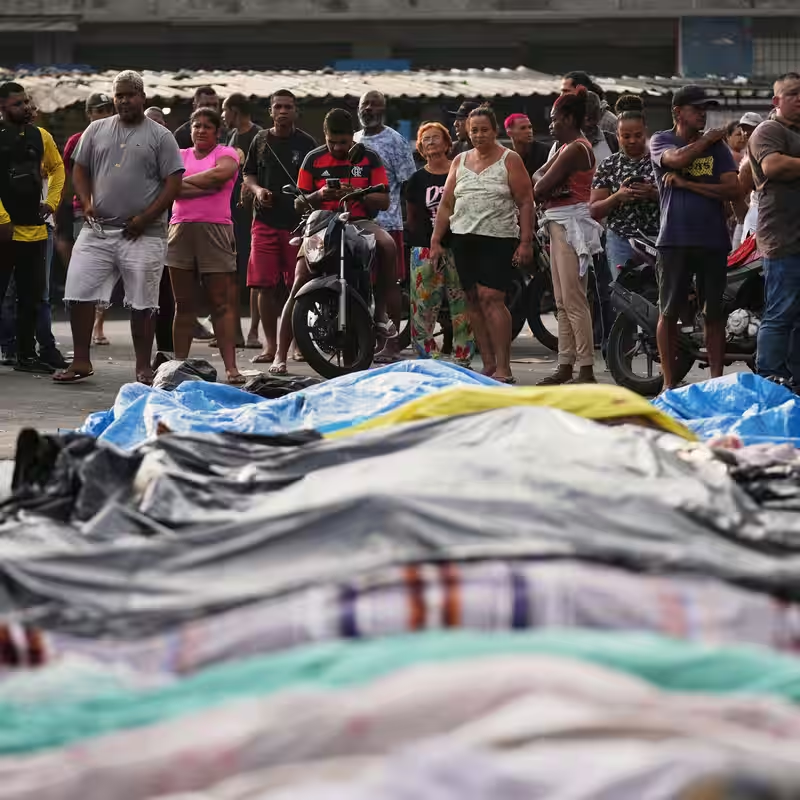Table of Contents
- Deadliest Raid in Rio History
- Chaos Unfolds Before Dawn
- Failed Mission and Public Outrage
- Political Fallout and Expert Critique
- What Happens Next?
- Sources
Deadliest Raid in Rio History
In what has become the bloodiest police operation in Rio de Janeiro’s turbulent history, at least 132 people—including four officers—were killed during a massive anti-gang raid targeting the notorious Red Command drug faction. The staggering death toll, confirmed by Rio’s public defender’s office, has triggered national shockwaves and renewed debate over Brazil’s militarized approach to urban crime.
Residents in the affected low-income neighborhoods described scenes of horror: bodies lined up on sidewalks, many stripped to their underwear for identification, others covered by bedsheets to shield them from public view. Volunteers combed nearby wooded areas through the night, recovering dozens more corpses—raising urgent questions about who exactly died, and at whose hands.
Chaos Unfolds Before Dawn
The operation began around 3:30 a.m. on Tuesday, October 28, 2025, when power and internet services abruptly cut out across several favelas on Rio’s outskirts. By 5 a.m., gunfire erupted as roughly 2,500 police officers, backed by armored vehicles and helicopters, stormed the area.
Gang members retaliated with shocking sophistication—using drones to drop explosives from above and setting cars ablaze as barricades. The violence paralyzed daily life: schools closed, clinics shuttered, and terrified families huddled in interior rooms as bullets flew.
“We woke up to the sounds of gunshots—from here, from there, from everywhere,” said community leader Rene Silva.
By afternoon, the chaos spread citywide. Gang affiliates hijacked buses and blocked major roads—including one leading to Rio’s international airport—amplifying fears of a city spiraling out of control.
Failed Mission and Public Outrage
Despite declaring the raid a “success,” authorities admitted a critical failure: they did not capture the operation’s primary target—a top Red Command leader.
“He uses the foot soldiers as a kind of barrier,” confessed Rio’s Secretary of Public Security, Victor Santos, in a televised interview.
Meanwhile, the true human cost remains murky. Of the 132 dead, it’s unclear how many were armed traffickers, innocent bystanders, or victims of extrajudicial killings. Forensic teams, now aided by Brazil’s federal government, are working to identify remains and determine causes of death.
Political Fallout and Expert Critique
Rio’s far-right governor, Cláudio Castro, defended the raid, citing the arrest of 113 suspects and the seizure of 118 weapons and a ton of drugs. He labeled the Red Command’s actions as “narco-terrorism”—a term echoing former President Jair Bolsonaro’s hardline rhetoric.
But critics argue this was less about public safety and more about political theater ahead of Brazil’s 2026 elections.
“We’ve seen time and time again that heavy-handed approaches do not dismantle criminal networks,” said Robert Muggah, research director at the Igarapé Institute. “Mega-operations like this mostly kill low-level dealers while leaving the real power structures untouched.”
Experts point to São Paulo’s recent success against the First Capital Command—a rival gang—by targeting its financial pipelines rather than engaging in street warfare.
What Happens Next?
President Luiz Inácio Lula da Silva, “stunned” by the scale of violence, dispatched a federal crisis team to Rio. The timing is especially sensitive: Brazil is set to host the upcoming U.N. climate conference in Rio and Belém, drawing global attention to its security challenges.
Human rights organizations are demanding an independent investigation. Meanwhile, residents of the raided communities say they feel abandoned—caught between ruthless gangs and trigger-happy police.
As one anonymous resident put it: “It was pure despair. We just wanted to survive the night.”




